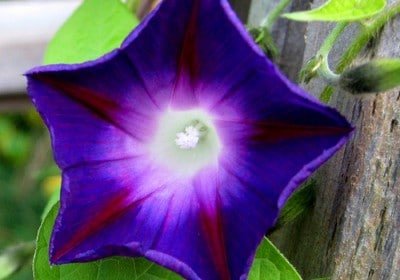
It’s impossible to think of morning glories without calling up an image of ‘Heavenly Blue’ (Ipomoea tricolor ‘Heavenly Blue’), the classic sky blue flowers with deep white throats. Now there are additional colours to think about, including ‘La Vie en Rose’, a blend of pale pink to deep rose and red; ‘Dacapo Blue’, a pale blue flower with purple striping; ‘Flying Saucers’, blue flowers marbled with white and purple; and ‘Milky Way’, white flowers with blue or maroon striping. There are also double flowers, like ‘Split Second’ and ‘Cotton Candy’, with wavy rose-pink petals that look like peonies.
These cultivars of I. tricolor produce frost-tender seeds that usually won’t survive outdoors over winter. They require warm soil to germinate, and are best started indoors in spring for setting out in late May, with flowers starting in mid-summer.
My favourites are the darker morning glories that are heirloom hybrids of I. purpurea, producing half-hardy seeds that will often remain in the soil over winter and sprout in early spring. Seeds can also be harvested when their capsules are dry in late summer, and planted out in cold spring soil. ‘Star of Yelta’ has midnight-blue petals with crimson stripes and a fuchsia throat leading down a white tube to a green heart. That’s a lot of dramatic colour packed into one flower!
Another dark morning glory is ‘Grandpa Ott’, with dark maroon petals, brilliant red star ribbing and white throat. ‘President Tyler’ is dark blue with maroon-black ribs and a pink star leading to a white throat. Other named vines you might find are ‘Kniola’s Black Night’ and ‘Midnight Velvet’, both showing similar dark blue, fuchsia and white coloration (in fact, they may all be so closely related, that they’re virtually the same plant). These vines make flowers of various sizes, although none competes against the huge blossom dimensions of ‘Heavenly Blue’. ‘President Tyler’ is reputed to have the largest blooms of the dark morning glories, although blossom size is affected by growing conditions and is often inconsistent.
Morning glories take some time to get started. Nicking their thick coats with a sharp knife or scuffing them up helps them absorb water. I use an emery board (or sandpaper) to thin a small spot in the seed coats, pressing each seed against the rough surface and rubbing it gently back and forth a few times. Then I soak the seeds overnight, and plant them directly into patio containers with an obelisk climbing structure over the pot. (These preparations aren’t absolutely necessary, and the seeds will germinate without abrasion or soaking, taking perhaps only a few days longer.) When planted into a garden bed with a trellis or fence close by, expect prolific growth and hundreds of flowers lasting into October.
You can fertilize morning glories if you wish, using a low, balanced fertilizer analysis like 7-7-7 or something similar, but it isn’t necessary to provide supplemental nutrition; the vines do well in lean soil. Avoid giving them too much nitrogen (the first number in the analysis), as it encourages lush foliage growth and fewer flowers.
Morning glories are prolific seed producers. Watch for their seed capsules and when they appear ripe and entirely dry, clean the seeds and keep some in an envelope for next year, to grow alongside purchased seeds. Seed saved from hybrid varieties may not come true, and you could end up growing an ancestor. But it’s interesting to see who’s in the family!
